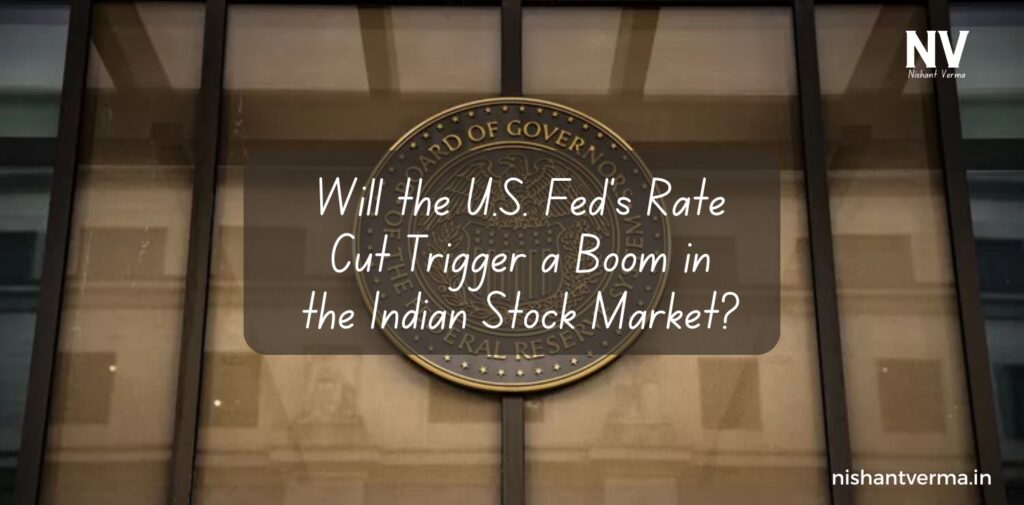The U.S. Federal Reserve’s decision to cut interest rates in September 2024 has significant implications for global markets, including India. This rate cut, designed to stimulate the U.S. economy, is expected to have far-reaching effects on the Indian stock market and its traders.
How the U.S. Fed’s Rate Cut Impacts Global Markets
When the U.S. Federal Reserve lowers interest rates, it reduces the returns on U.S. assets, particularly government bonds. This makes emerging markets like India more attractive for foreign portfolio investors (FPIs) seeking higher yields. Historically, rate cuts by the Fed have often triggered a shift in capital flows towards high-growth markets such as India. In this case, India’s strong GDP growth, stable political environment, and robust domestic consumption make it a prime destination for FPI inflows.

Impact on Indian Stock Market
- FPI Inflows and Stock Market Liquidity: With U.S. bond yields becoming less attractive, FPIs are expected to pour more money into Indian equities. Already, FPIs had been net sellers in August due to concerns about U.S. monetary policy, but this rate cut could reverse that trend, leading to renewed FPI interest in Indian markets. According to experts, large-cap stocks in sectors like financial services, capital goods, and FMCG are expected to benefit the most. Additionally, lower U.S. interest rates typically lead to a weakening of the U.S. dollar, which increases the relative attractiveness of Indian assets. For traders, this could mean a bullish sentiment in Indian markets as more foreign capital drives up stock prices and improves liquidity.
- Sector-Wise Impact: Indian sectors that are likely to see the biggest gains from the Fed’s rate cut include IT, banking, financial services, and real estate. The IT sector, in particular, could benefit from a weaker dollar, while banks and financial services may see increased capital inflows, driving up stock prices. Furthermore, with increased consumer spending and capital investments, capital goods and FMCG are also expected to thrive.
- Volatility and Risk Management: While the Fed’s rate cut may signal bullish trends in Indian stocks, traders should be prepared for volatility. Historically, rate cuts can lead to short-term market corrections as global investors adjust their portfolios. For Indian traders, this means opportunities for profit-taking, but also the need for cautious risk management. Analysts point out that Nifty and Sensex have been trading near record highs, and any misinterpretation of the Fed’s future stance could lead to market corrections.

Influence on Domestic Traders and Investors
For domestic traders, the rate cut represents both opportunities and challenges. While FPIs may drive stock prices higher, making the market attractive for short-term trading, long-term investors should focus on sectors that are poised for sustained growth. Analysts recommend keeping an eye on sectors like banking and financial services, which are expected to benefit from increased liquidity and consumer demand.
- Investment Opportunities: Traders who take advantage of dips caused by short-term volatility could see significant gains, especially in large-cap stocks. With the Indian market already supported by strong domestic demand, infrastructure spending, and government policies, sectors such as auto, realty, and financial services present lucrative opportunities.
- Global Risk Factors: Despite the optimism, traders should remain cautious about global economic conditions. Crude oil prices, geopolitical tensions, and other macroeconomic factors could still influence market performance. As seen during previous global economic shifts, the Indian stock market can be sensitive to these triggers, and traders should diversify their portfolios to mitigate risks.
- Potential for Long-Term Growth in Indian Markets: India’s growth trajectory, driven by increasing consumption and infrastructure development, positions it as a favorable market in the medium to long term. The rate cut by the Fed is likely to contribute to higher liquidity, making it easier for Indian companies to access capital for expansion. Moreover, sectors like real estate, which often benefit from lower interest rates, may see a resurgence as both domestic and foreign investors become more active.

This increased investment could also benefit smaller companies listed on the BSE and NSE, as more funds become available for IPOs and other capital-raising activities. For traders focusing on these smaller stocks, the Fed’s rate cut may offer a unique opportunity to invest in high-growth sectors that are not as dependent on global factors as large-cap companies.
Conclusion: A Bullish Outlook, With Caution
The U.S. Federal Reserve’s rate cut is expected to bring renewed optimism to the Indian stock market, with FPIs likely to re-enter in search of higher yields. However, traders should remain vigilant about short-term volatility and potential global risks. Sectors such as IT, banking, financial services, and real estate are expected to be the biggest beneficiaries of the rate cut. For Indian traders, both short-term trading and long-term investment opportunities are abundant, but risk management remains key.
As always, traders and investors should consult with certified financial advisors before making major investment decisions, especially in such a dynamic and rapidly changing global environment.




